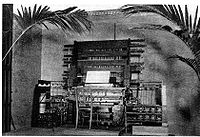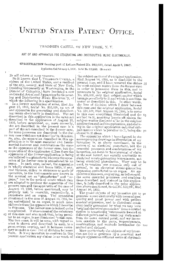
Telharmonium
Encyclopedia

Electronic musical instrument
An electronic musical instrument is a musical instrument that produces its sounds using electronics. Such an instrument sounds by outputting an electrical audio signal that ultimately drives a loudspeaker....
, developed by Thaddeus Cahill
Thaddeus Cahill
Thaddeus Cahill was a prominent inventor of the early 20th century. He is widely credited with the invention of the first electromechanical musical instrument, which he dubbed the telharmonium....
in 1897. The electrical signal from the Telharmonium was transmitted over wires; it was heard on the receiving end by means of 'horn' speakers.
Like the later Hammond organ
Hammond organ
The Hammond organ is an electric organ invented by Laurens Hammond in 1934 and manufactured by the Hammond Organ Company. While the Hammond organ was originally sold to churches as a lower-cost alternative to the wind-driven pipe organ, in the 1960s and 1970s it became a standard keyboard...
, the Telharmonium used tonewheel
Tonewheel
A tonewheel is a simple electromechanical apparatus for generating electronic musical notes. The tonewheel assembly consists of a synchronous AC motor and an associated gearbox that drives a series of rotating disks...
s to generate musical sounds as electrical signals by additive synthesis
Additive synthesis
Additive synthesis is a technique of sound synthesis that creates musical timbre by explicitly adding sinusoidal overtones together.The timbre of an instrument is composed of multiple harmonic or inharmonic partials , of different frequencies and amplitudes, that change over time...
.

The Telharmonium foreshadowed modern electronic
Electronics
Electronics is the branch of science, engineering and technology that deals with electrical circuits involving active electrical components such as vacuum tubes, transistors, diodes and integrated circuits, and associated passive interconnection technologies...
musical equipment in a number of ways. For instance, its sound output came in the form of connecting ordinary telephone receivers to large paper cones — a primitive form of loudspeaker
Loudspeaker
A loudspeaker is an electroacoustic transducer that produces sound in response to an electrical audio signal input. Non-electrical loudspeakers were developed as accessories to telephone systems, but electronic amplification by vacuum tube made loudspeakers more generally useful...
. Indeed, Cahill was noted for saying that electromagnetic
Electromagnetism
Electromagnetism is one of the four fundamental interactions in nature. The other three are the strong interaction, the weak interaction and gravitation...
diaphragms were the most preferable means of outputting its distinctive sound.
Although no recordings exist of the Telharmonium, observers reported that its sound was very clear and pure — probably referring to the sine tones it was capable of producing. However, it was not restricted to such simple sounds. Each tonewheel of the instrument corresponded to a single note, and, to broaden its possibilities, Cahill added several extra tonewheels to add harmonic
Harmonic
A harmonic of a wave is a component frequency of the signal that is an integer multiple of the fundamental frequency, i.e. if the fundamental frequency is f, the harmonics have frequencies 2f, 3f, 4f, . . . etc. The harmonics have the property that they are all periodic at the fundamental...
s to each note. This, combined with organ
Organ (music)
The organ , is a keyboard instrument of one or more divisions, each played with its own keyboard operated either with the hands or with the feet. The organ is a relatively old musical instrument in the Western musical tradition, dating from the time of Ctesibius of Alexandria who is credited with...
-like stops and multiple keyboards (the Telharmonium was polyphonic), as well as a number of foot pedals, meant that every sound could be sculpted and reshaped — the instrument was noted for its ability to reproduce the sounds of common orchestral woodwind instruments such as the flute
Flute
The flute is a musical instrument of the woodwind family. Unlike woodwind instruments with reeds, a flute is an aerophone or reedless wind instrument that produces its sound from the flow of air across an opening...
, bassoon
Bassoon
The bassoon is a woodwind instrument in the double reed family that typically plays music written in the bass and tenor registers, and occasionally higher. Appearing in its modern form in the 19th century, the bassoon figures prominently in orchestral, concert band and chamber music literature...
, clarinet
Clarinet
The clarinet is a musical instrument of woodwind type. The name derives from adding the suffix -et to the Italian word clarino , as the first clarinets had a strident tone similar to that of a trumpet. The instrument has an approximately cylindrical bore, and uses a single reed...
, and also the cello
Cello
The cello is a bowed string instrument with four strings tuned in perfect fifths. It is a member of the violin family of musical instruments, which also includes the violin, viola, and double bass. Old forms of the instrument in the Baroque era are baryton and viol .A person who plays a cello is...
.
The Telharmonium's demise came for a number of reasons. Its immense size, weight and power consumption (this being in an age before vacuum tube
Vacuum tube
In electronics, a vacuum tube, electron tube , or thermionic valve , reduced to simply "tube" or "valve" in everyday parlance, is a device that relies on the flow of electric current through a vacuum...
s had been invented) caused obvious problems. In addition, problems began to arise when telephone broadcasts of Telharmonium music were subject to crosstalk and unsuspecting telephone users would be interrupted by strange electronic music. By 1912, interest in this revolutionary instrument had changed, and Cahill's company was later declared not successful in 1914.
Cahill died in 1934; his younger brother retained the Mark I for decades, but was unable to interest anyone in it. This was the last version to be scrapped, in 1962.
External links
- Telharmonium, Audion Piano, Luigi Russsolo et les bruitistes sonhors.free.fr, French

